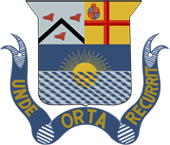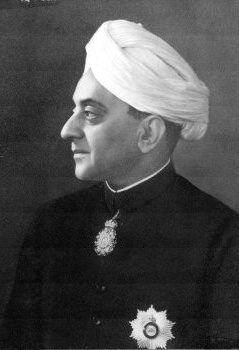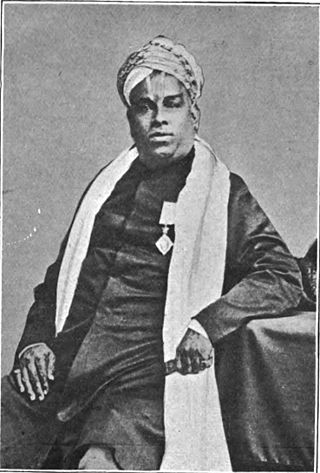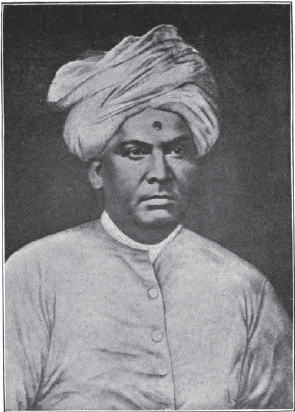Related Research Articles

Presidency College is an art, commerce, and science college in the city of Chennai in Tamil Nadu, India. On 16 October 1840, this school was established as the Madras Preparatory School before being repurposed as a high school, and then a graduate college. The Presidency College is one of the oldest government arts colleges in India. It is one of two Presidency Colleges established by the British in India, the other being the Presidency College, Kolkata.

Dewan Bahadur Sachivottama SirChetput Pattabhiraman Ramaswami IyerLL.D. D.Litt., popularly known as Sir C. P., was an Indian lawyer, administrator and statesman, acknowledged as the most powerful man in the Madras Presidency in the decades immediately prior to Indian Independence.

Raja Sir Tanjore Madhava Rao, KCSI, also known as Sir Madhava Rao Thanjavurkar or simply as Madhavarao Tanjorkar, was an Indian statesman, civil servant, administrator and politician who served as the Diwan of Travancore from 1857 to 1872, Indore from 1873 to 1875 and Baroda from 1875 to 1882. He was the nephew and son of the former Travancore Diwans T. Venkata Rao and T. Ranga Rao.

Seshadri Srinivasa Iyengar CIE, also seen as Sreenivasa Iyengar and Srinivasa Ayyangar, was an Indian lawyer, freedom-fighter and politician from the Indian National Congress. Iyengar was the Advocate-General of Madras Presidency from 1916 to 1920. He also served as a member of the bar council from 1912 to 1920, the law member of Madras Presidency from 1916 to 1920 and as the president of the madras province Swarajya Party faction of the Indian National Congress from 1923 to 1930. Srinivasa Iyengar was the son-in-law of renowned lawyer and first Indian Advocate-general of Madras, Sir Vembaukum Bhashyam Aiyangar. Iyengar's followers called him Lion of the South.

Minjur Bhakthavatsalam was an Indian independence activist and politician who served as the chief minister of Madras State from 2 October 1963 to 6 March 1967. He was the last Congress chief minister of Tamil Nadu and the last to have taken part in the Indian independence movement.

Tamil Nadu Legislative Council was the upper house of the former bicameral legislature of the Indian state of Tamil Nadu. It began its existence as Madras Legislative Council, the first provincial legislature for Madras Presidency. It was initially created as an advisory body in 1861, by the British colonial government. It was established by the Indian Councils Act 1861, enacted in the British parliament in the aftermath of the Indian Rebellion of 1857. Its role and strength were later expanded by the second Council Act of 1892. Limited election was introduced in 1909. The Council became a unicameral legislative body in 1921 and eventually the upper chamber of a bicameral legislature in 1937. After India became independent in 1947, it continued to be the upper chamber of the legislature of Madras State, one of the successor states to the Madras Presidency. It was renamed as the Tamil Nadu Legislative Council when the state was renamed as Tamil Nadu in 1969. The Council was abolished by the M. G. Ramachandran administration on 1 November 1986. In 1989, 1996 and 2010, the DMK regime headed by M. Karunanidhi tried to revive the Council. The former AIADMK regime (2016-2021) expressed its intention not to revive the council and passed a resolution in the Tamil Nadu Legislative Assembly in this regard.

Vembaukum RamiengarCSI, also rendered Vembakkam and Rama Iengar, was an Indian civil servant, administrator, and statesman who served Sir Visakham Thirunal Rama Varma V, Maharaja of Travancore and his successor Sir Mulam Thirunal Rama Varma VI, as Diwan of Travancore from 1880 to 1887 after a lengthy career in governance in the Madras Presidency, culminating in his membership of the Madras Legislative Council from 1867 to 1879. He was a trustee of Pachaiyappa's Charities, and a member of the powerful and accomplished Vembaukum clan of Vadakalai Iyengar Brahmins originating in Vembakkam, which also produced or encompassed such contemporaries as lawyers V. Sadagopacharlu and V. Rajagopalacharlu, and Sir V. Bhashyam Aiyangar; Mysore Dewan C. V. Rungacharlu; and Madras Deputy Superintendent of Police V. Raghavachariar.

Diwan Bahadur SirVembakkam Bhashyam AiyangarKt. was a lawyer and jurist who served as the first Indian Advocate-General of the Madras Presidency and later, as a Justice of the High Court of Madras.

Gazulu Lakshminarasu ChettyCSI was an Indian merchant and political activist who founded the Madras Native Association, one of the earliest Indian political associations, and the first Indian-owned newspaper in Madras, The Crescent. He was also the second Indian to be appointed a member of the Madras Legislative Council, succeeding V. Sadagopacharlu on his death. Lakshminarasu Chetty was born in 1806 to a wealthy indigo merchant Sidhulu Chetty in Madras. On completion of his initial education, Chetty entered the family trade and succeeded as a businessman. He entered politics and devoted money for social and philanthropic causes.

Sir Benegal Narsing Rau was an Indian civil servant, jurist, diplomat and statesman known for his key role in drafting the Constitution of India, He was the Constitutional Advisor to Constituent Assembly. He was also India's representative to the United Nations Security Council from 1950 to 1952. His brothers were Governor of the Reserve Bank of India Benegal Rama Rau and journalist and politician B. Shiva Rao.
Tiruppur Angappa Ramalingam Chettiar was an Indian lawyer, politician, member of parliament and businessman from the Indian state of Tamil Nadu.
Anglo-Hindu law is the case law that developed in British India, through the interpretation of the Hindu scriptures and customary law in the British courts.
Sir Vembakkam Comanduru Desikachariar was an Indian lawyer, politician and Indian independence activist who served as a member of the Madras Legislative Council from 1904 to 1908.

The Right Hon. Calamur ViravalliRunganada Sastri was an Indian interpreter, jurist, civil servant, polyglot, and social reformer, who was known for his mastery over Indian and foreign languages alike in both classical and vernacular forms, as well as his general erudition and command of jurisprudence. At his death, he is known to have mastered fourteen languages, and had a conversational command of at least two to four more.
Charles Pelly was a British civil servant of the Indian Civil Service who served as the revenue member of the Madras Legislative Council from 1862 to 1866. He was reappointed as an additional Member in 1866.

John Dawson Mayne (1828–1917) was a British lawyer and legal expert who served as acting Advocate-General of the Madras Presidency. He is remembered as the author of Mayne's Hindu Law regarded as the most authoritative book on the Indian Penal Code. His married life was marred by a scandal, which prevented him from gaining a knighthood.

Sir Thyagaraja Sadasiva Iyer was an Indian judge and theosophist who served as the Chief Justice of Travancore from 1905 to 1910. He was also the first President of the Hindu Religious and Charitable Endowments Department, Madras Presidency.

The Vembaukum or Vembakkam family were one of the two preeminent Brahmin dynasties in the Madras Presidency, dominating the Mylapore clique alongside the Calamur clan, and 'possess(ing) an enormous presence in the... bureaucracy of the capital and its surrounding district(s)', whose historical presence began in the 1820s, with the sprawling clan famously having begun holding yearly family conferences by the 1890s to preserve their dynastic unity, political cohesion and influence, and wealth.
Vembakkam Comanduru Gopalratnam, son of Sir V. C. Desikachariar, grandson of V. Rajagopalacharlu, grandnephew of V. Sadagopacharlu, brother-in-law of K. Bhashyam Iyengar, and son-in-law of V. V. Srinivasa Iyengar, was himself a top-ranking lawyer, writer, humorist, and legal historian, whose magnum opus was The High Court , finished just months before his death in 1962. He was also author of Hāsya Nāṭakaṅkaḷ Kaṭṭuraikaḷ, a work in Tamil. A member of the Vembaukum family, he co-edited the quarterly trade journal The Lawyer and was partially resident in Vasantavilas, where he took on as a junior a youthful Randor Guy.
V. Rajagopalacharlu (1830-1868) was an Indian lawyer, jurist, and Hindu religious reformer, who was of the first Indians in the colonial epoch to achieve wealth and renown in the courts of British India, accomplishing both alongside his brother, V. Sadagopacharlu, in the judicial system of the Madras Presidency, in which they were leading Vakils. He also was an advocate of religious reform within Hinduism, as the primary exponent of the Brahmo Samaj movement in South India.
References
- 1 2 3 Price, Pamela G. (1996). Kingship and political practice in colonial India. University of Cambridge Oriental publications (1. publ ed.). Cambridge: Cambridge Univ. Press. ISBN 978-0-521-55247-9.
- ↑ N.S.Chandrasekhara (22 August 2016). Dewan Shashadri Aiyer. Publications Division Ministry of Information & Broadcasting. ISBN 9788123026572.
- 1 2 3 "The tragedy at Vembakkam". The Hindu. 5 November 2012. ISSN 0971-751X . Retrieved 30 March 2024.
- ↑ Gopalratnam, V. C. (1962). A Century Completed: A History of the Madras High Court, 1862-1962. Madras Law Journal Office.
- ↑ "Ragavendra Rau And Anr. vs Jayaram Rau on 30 March, 1897". indiankanoon.org. Retrieved 30 March 2024.
- Muthiah, S. (2004). Madras Rediscovered. East West Books (Madras) Pvt Ltd. p. 418. ISBN 81-88661-24-4.